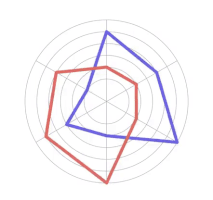Buildings and spaces must be designed to be usable by people of all abilities, ages, and backgrounds, also known as “Barrier free design”. The users must be in a position to be almost completely independent of outside help. This applies especially to wheelchair users. Here are the different wheelchair-accessible areas - Walkways, Parking, Toilets, Lifts & Ramps, and a guide to designing them properly.
Understanding Wheelchair Dimensions
The design process starts with understanding wheelchair dimensions and requirements. An essential aspect is the turning radius of a wheelchair, which is defined as a circular space that allows a wheelchair to make a 180-degree or 360-degree turn. This requires a minimum diameter of, 1500mm.
Illustration credits: Sonali K, Dimensions.guide
Turning Radius of a wheelchair
Defined as a circular space that allows a wheelchair to make a 180-degree or 360-degree turn, it requires a 1500mm minimum diameter turning space.
Main movement areas:
1. Walkways - Walkways need to accommodate both single and two-way wheelchair traffic. The minimum width of an unobstructed pathway should be 900mm to ensure a comfortable passage. For two-way traffic, the minimum width should be 1500mm, with a preferable width of 1800mm to allow for ease of movement. Additionally, the slope of an accessible path should not exceed 1:20 to ensure safety and ease of use.
Illustration credits: Sonali K, Dimensions.guide
2. Parkings - Parking spaces must also be accessible. Standard parking spaces should be 2400mm wide, while van-accessible spaces should be 3350mm wide to accommodate larger vehicles. Access aisles, which allow individuals to deploy vehicle-mounted wheelchair lifts or use mobility devices such as wheelchairs, must be 1500mm wide.
Illustration credits: Sonali K, Dimensions.guide
3. Toilets - Toilets need specific dimensions and fittings to be accessible. Accessible toilet rooms should have minimum internal dimensions of 2200mm × 2300mm. The minimum size for a toilet designed for physically handicapped individuals is 1500mm x 1750mm. Suitable arrangements of vertical and horizontal handrails with a 50mm clearance from the wall should be made in the toilet to provide the necessary support and independence for users.
Illustration credits: Sonali K, Dimensions.guide
4. Lifts - Lifts must be designed to accommodate wheelchair users. According to building bye-laws, a lift should have a clear internal depth of 1100mm and a clear internal width of 2000mm, with an entrance door width of 900mm. A handrail, not less than 600mm long and positioned at 800-1000mm above floor level, should be fixed adjacent to the control panel. The internal measurement of a lift lobby should be at least 1800mm x 1800mm to allow easy maneuvering.
Illustration credits: Sonali K, Dimensions.guide
5. Ramps - Ramps are a critical component of wheelchair accessibility. An entrance landing should be provided adjacent to the ramp with minimum dimensions of 1.8m x 2.0m. The finishes on ramps should have a non-slip surface with a texture that is traversable by a wheelchair. Curbs, wherever provided, should blend to a common level to avoid obstacles.
Illustration credits: Sonali K, Dimensions.guide
Designing for Accessibility: Best Practices
Designing buildings that are truly accessible involves considering more than just the physical dimensions of spaces and fixtures. Here are some best practices to ensure accessibility:
Clear Signage: Use clear, easy-to-read signage to direct users to accessible features. Symbols and Braille can be used for visually impaired individuals.
Adequate Lighting: Ensure that all areas, especially those used by wheelchair users, are well-lit to prevent accidents and make navigation easier.
Smooth Surfaces: Floors should be smooth and free of obstacles. Carpets, if used, should be low-pile to allow easy movement of wheelchairs.
Accessible Controls: Light switches, door handles, and other controls should be within easy reach of wheelchair users, typically between 900mm and 1200mm above the floor.
Emergency Exits: Ensure that all emergency exits are accessible. This includes having ramps and wide doorways to allow for quick and safe evacuation.
The Importance of Inclusive Design
Inclusive design benefits everyone, not just wheelchair users. It ensures that buildings are accessible to people with various disabilities, older adults, and even parents with strollers. Following the guidelines for accessible design, architects can create spaces that are welcoming and usable by all members of the community.
Moreover, accessible design is not only a legal requirement in many places but also a moral obligation. It demonstrates a commitment to equality and respect for all individuals, regardless of their physical abilities. In the long run, it fosters a more inclusive society where everyone can participate fully and independently in daily activities.
Conclusion
Designing wheelchair-accessible buildings requires careful consideration of various factors, from walkway widths to the dimensions of lifts and toilets. Adhering to established guidelines and best practices, architects create spaces that are truly inclusive and barrier-free. This approach meets legal requirements and promotes independence and dignity for all users. As we move towards a more inclusive future, the principles of barrier-free design will play a crucial role in shaping our built environment.
The future of architecture is bright, but are your skills keeping pace? Kaarwan's architecture-specific courses provide you with the knowledge and tools to confidently navigate the AEC industry. Gain valuable insights, master in-demand software, and stand out with designs that impress!
FAQs
How to design a wheelchair accessible home?
Design a wheelchair-accessible home by ensuring wide doorways, low countertops, ramps instead of stairs, accessible bathrooms, and open floor plans for easy movement.
How to make a building wheelchair accessible?
Make a building wheelchair accessible by installing ramps, elevators, wide doorways, accessible restrooms, and clear pathways without obstacles.
Why is accessibility important in building design?
Accessibility is important in building design to ensure that people of all abilities can safely and comfortably use the space, promoting inclusivity and equal access.
What are the features of wheelchair design?
Features of wheelchair design include adjustable seating, easy maneuverability, strong but lightweight frames, and comfort features like cushions and armrests.
What is wheelchair accessibility?
Wheelchair accessibility refers to the design and modification of spaces to ensure that they can be easily accessed and used by individuals using wheelchairs.
